Improving Financial Performance: An Applied Business Finance Report
VerifiedAdded on 2023/06/18
|12
|2577
|164
Report
AI Summary
This report provides an overview of applied business finance, emphasizing the importance of financial management, understanding financial statements, and utilizing ratio analysis. It details the role of financial management in planning, organizing, monitoring, and controlling financial resources to achieve business objectives. The report explains the three main financial statements—income statement, balance sheet, and cash flow statement—and how ratios are used to compare financial performance across different periods. It includes a financial analysis with profitability, efficiency and liquidity ratios. Furthermore, the report suggests processes for improving financial performance, such as increasing revenue, reducing costs, improving inventory turnover, and managing trade debtors and creditors. The conclusion underscores the significance of financial management in decision-making, planning, and fund allocation, highlighting its role in a company's economic stability and profitability. Desklib provides additional resources and solved assignments for students.
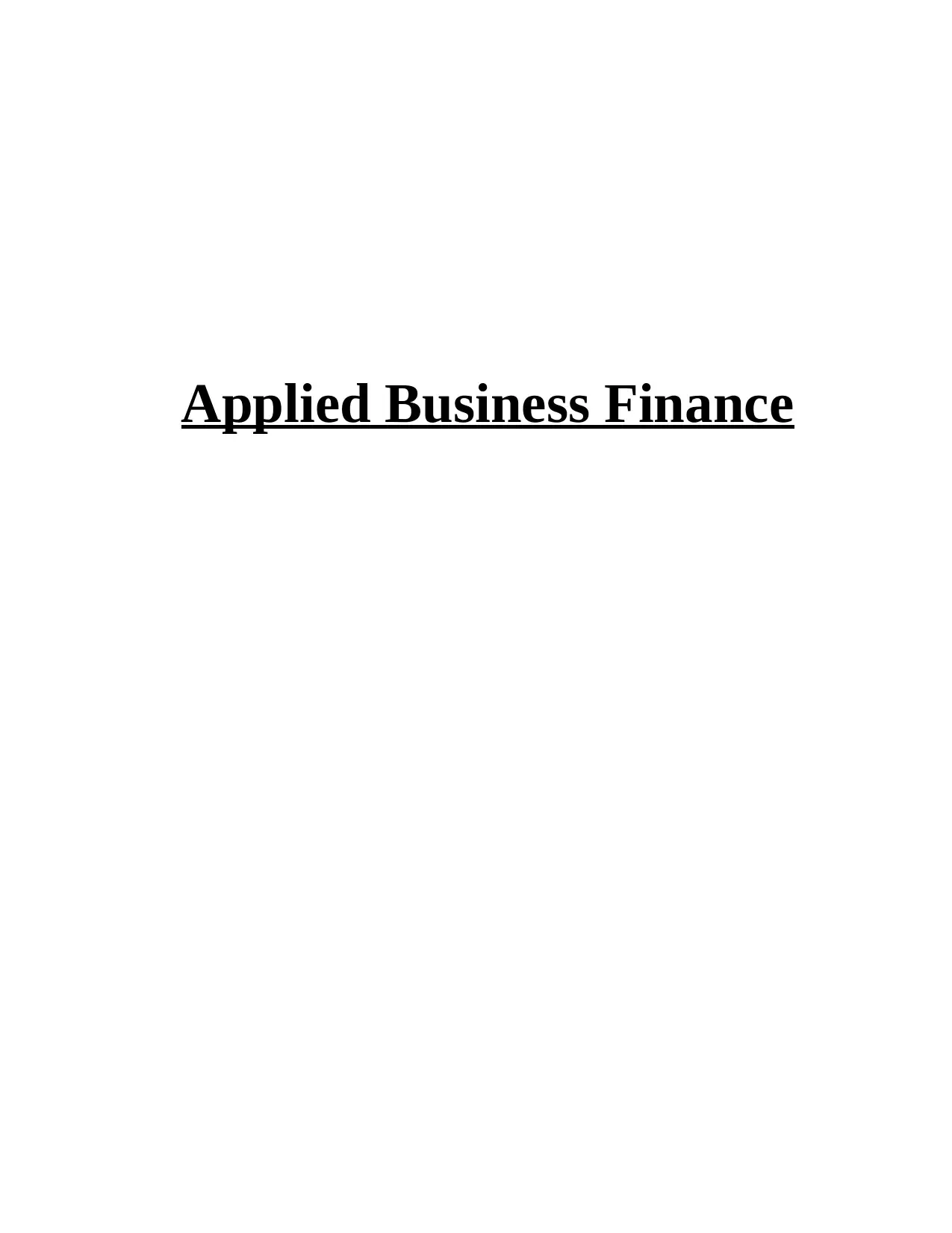
Applied Business Finance
Paraphrase This Document
Need a fresh take? Get an instant paraphrase of this document with our AI Paraphraser
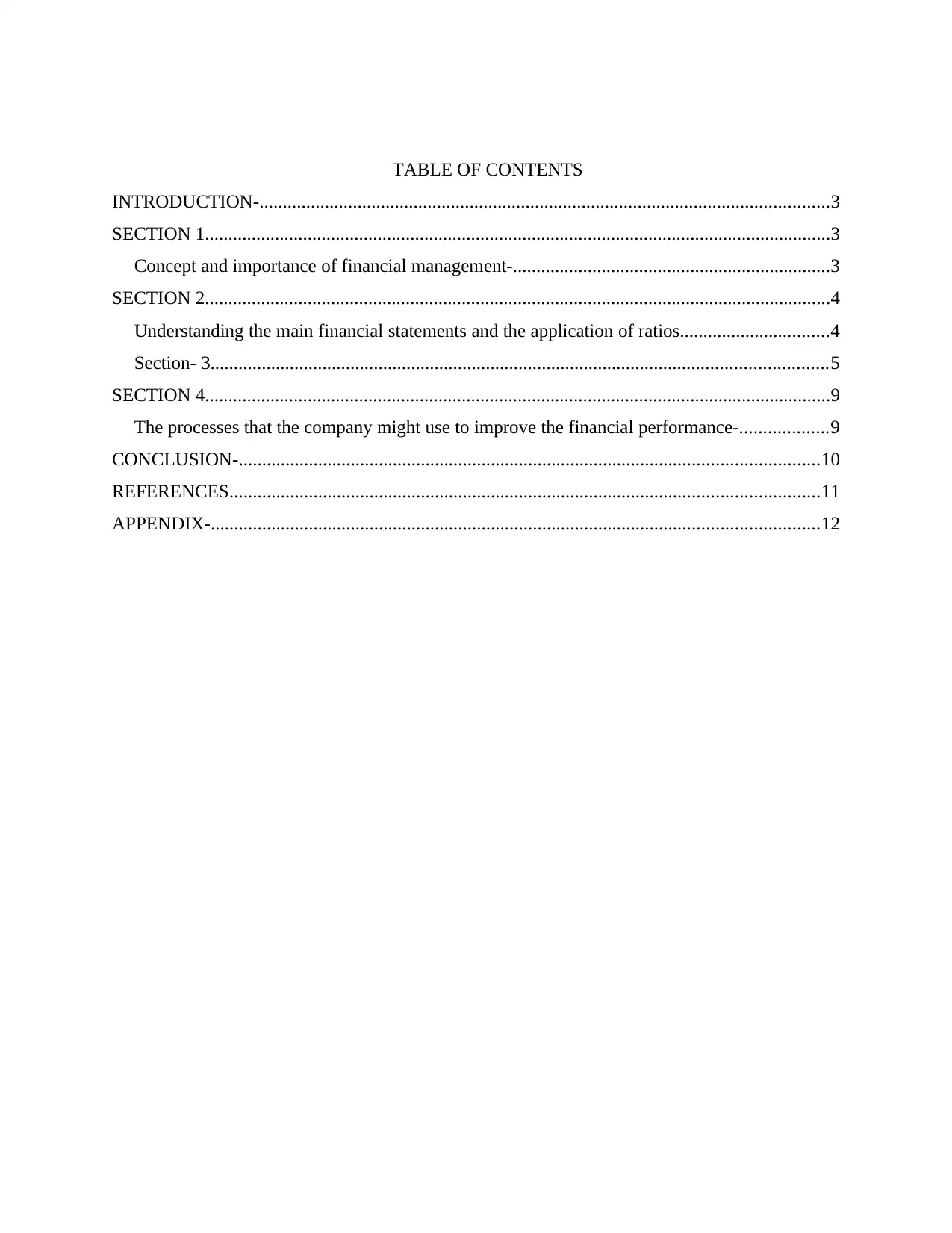
TABLE OF CONTENTS
INTRODUCTION-..........................................................................................................................3
SECTION 1......................................................................................................................................3
Concept and importance of financial management-....................................................................3
SECTION 2......................................................................................................................................4
Understanding the main financial statements and the application of ratios................................4
Section- 3....................................................................................................................................5
SECTION 4......................................................................................................................................9
The processes that the company might use to improve the financial performance-...................9
CONCLUSION-............................................................................................................................10
REFERENCES..............................................................................................................................11
APPENDIX-..................................................................................................................................12
INTRODUCTION-..........................................................................................................................3
SECTION 1......................................................................................................................................3
Concept and importance of financial management-....................................................................3
SECTION 2......................................................................................................................................4
Understanding the main financial statements and the application of ratios................................4
Section- 3....................................................................................................................................5
SECTION 4......................................................................................................................................9
The processes that the company might use to improve the financial performance-...................9
CONCLUSION-............................................................................................................................10
REFERENCES..............................................................................................................................11
APPENDIX-..................................................................................................................................12
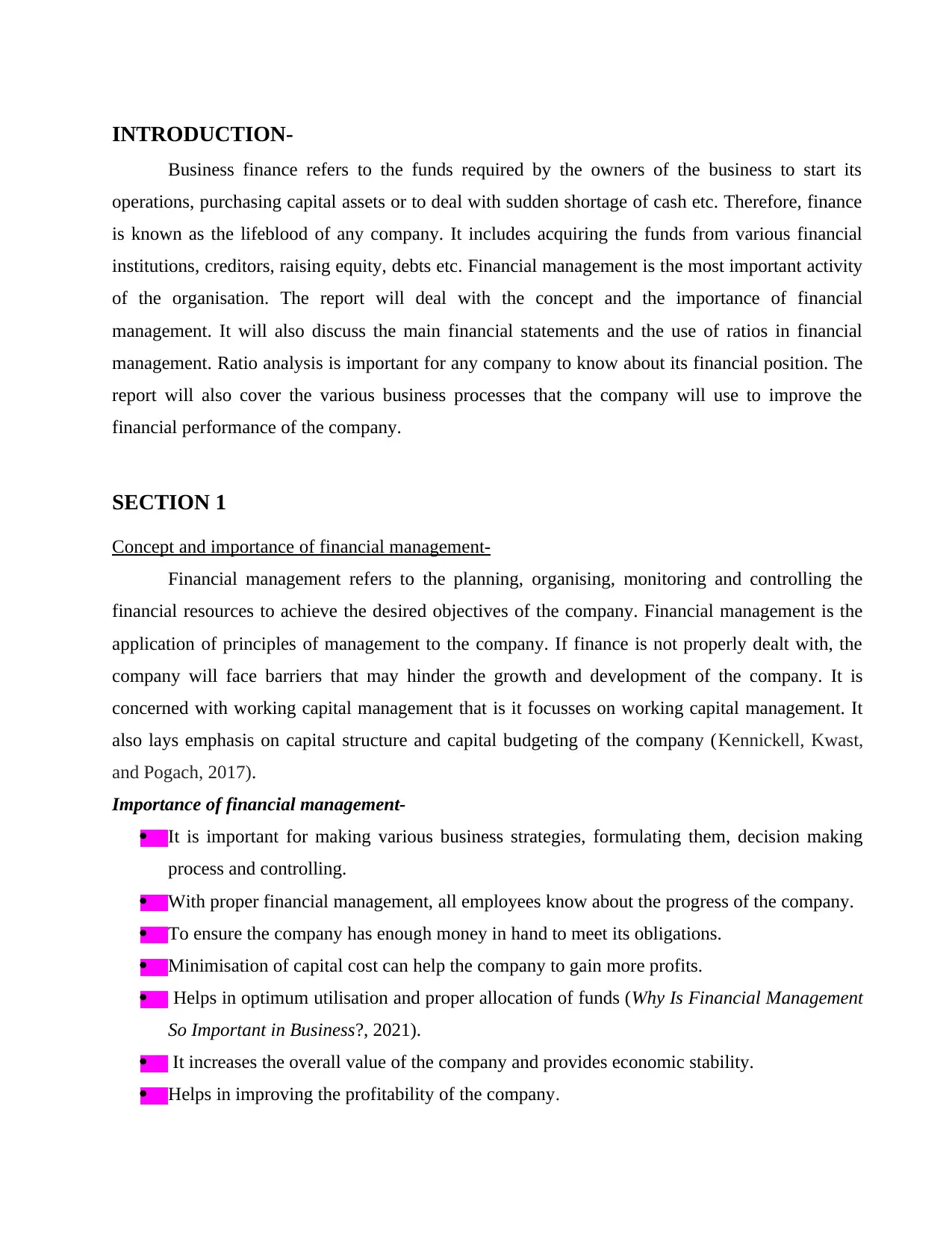
INTRODUCTION-
Business finance refers to the funds required by the owners of the business to start its
operations, purchasing capital assets or to deal with sudden shortage of cash etc. Therefore, finance
is known as the lifeblood of any company. It includes acquiring the funds from various financial
institutions, creditors, raising equity, debts etc. Financial management is the most important activity
of the organisation. The report will deal with the concept and the importance of financial
management. It will also discuss the main financial statements and the use of ratios in financial
management. Ratio analysis is important for any company to know about its financial position. The
report will also cover the various business processes that the company will use to improve the
financial performance of the company.
SECTION 1
Concept and importance of financial management-
Financial management refers to the planning, organising, monitoring and controlling the
financial resources to achieve the desired objectives of the company. Financial management is the
application of principles of management to the company. If finance is not properly dealt with, the
company will face barriers that may hinder the growth and development of the company. It is
concerned with working capital management that is it focusses on working capital management. It
also lays emphasis on capital structure and capital budgeting of the company (Kennickell, Kwast,
and Pogach, 2017).
Importance of financial management-
It is important for making various business strategies, formulating them, decision making
process and controlling.
With proper financial management, all employees know about the progress of the company.
To ensure the company has enough money in hand to meet its obligations.
Minimisation of capital cost can help the company to gain more profits.
Helps in optimum utilisation and proper allocation of funds (Why Is Financial Management
So Important in Business?, 2021).
It increases the overall value of the company and provides economic stability.
Helps in improving the profitability of the company.
Business finance refers to the funds required by the owners of the business to start its
operations, purchasing capital assets or to deal with sudden shortage of cash etc. Therefore, finance
is known as the lifeblood of any company. It includes acquiring the funds from various financial
institutions, creditors, raising equity, debts etc. Financial management is the most important activity
of the organisation. The report will deal with the concept and the importance of financial
management. It will also discuss the main financial statements and the use of ratios in financial
management. Ratio analysis is important for any company to know about its financial position. The
report will also cover the various business processes that the company will use to improve the
financial performance of the company.
SECTION 1
Concept and importance of financial management-
Financial management refers to the planning, organising, monitoring and controlling the
financial resources to achieve the desired objectives of the company. Financial management is the
application of principles of management to the company. If finance is not properly dealt with, the
company will face barriers that may hinder the growth and development of the company. It is
concerned with working capital management that is it focusses on working capital management. It
also lays emphasis on capital structure and capital budgeting of the company (Kennickell, Kwast,
and Pogach, 2017).
Importance of financial management-
It is important for making various business strategies, formulating them, decision making
process and controlling.
With proper financial management, all employees know about the progress of the company.
To ensure the company has enough money in hand to meet its obligations.
Minimisation of capital cost can help the company to gain more profits.
Helps in optimum utilisation and proper allocation of funds (Why Is Financial Management
So Important in Business?, 2021).
It increases the overall value of the company and provides economic stability.
Helps in improving the profitability of the company.
⊘ This is a preview!⊘
Do you want full access?
Subscribe today to unlock all pages.

Trusted by 1+ million students worldwide
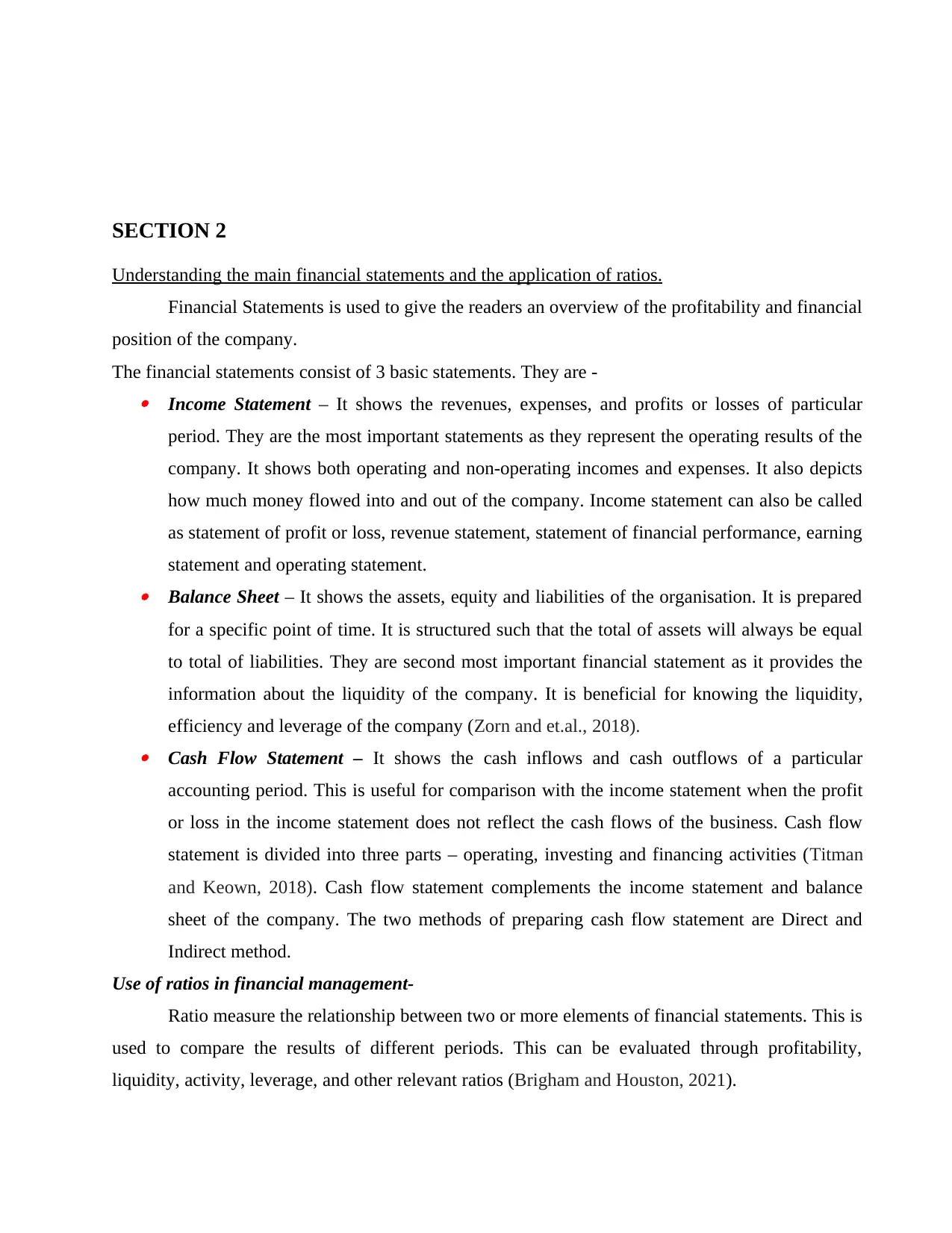
SECTION 2
Understanding the main financial statements and the application of ratios.
Financial Statements is used to give the readers an overview of the profitability and financial
position of the company.
The financial statements consist of 3 basic statements. They are - Income Statement – It shows the revenues, expenses, and profits or losses of particular
period. They are the most important statements as they represent the operating results of the
company. It shows both operating and non-operating incomes and expenses. It also depicts
how much money flowed into and out of the company. Income statement can also be called
as statement of profit or loss, revenue statement, statement of financial performance, earning
statement and operating statement. Balance Sheet – It shows the assets, equity and liabilities of the organisation. It is prepared
for a specific point of time. It is structured such that the total of assets will always be equal
to total of liabilities. They are second most important financial statement as it provides the
information about the liquidity of the company. It is beneficial for knowing the liquidity,
efficiency and leverage of the company (Zorn and et.al., 2018). Cash Flow Statement – It shows the cash inflows and cash outflows of a particular
accounting period. This is useful for comparison with the income statement when the profit
or loss in the income statement does not reflect the cash flows of the business. Cash flow
statement is divided into three parts – operating, investing and financing activities (Titman
and Keown, 2018). Cash flow statement complements the income statement and balance
sheet of the company. The two methods of preparing cash flow statement are Direct and
Indirect method.
Use of ratios in financial management-
Ratio measure the relationship between two or more elements of financial statements. This is
used to compare the results of different periods. This can be evaluated through profitability,
liquidity, activity, leverage, and other relevant ratios (Brigham and Houston, 2021).
Understanding the main financial statements and the application of ratios.
Financial Statements is used to give the readers an overview of the profitability and financial
position of the company.
The financial statements consist of 3 basic statements. They are - Income Statement – It shows the revenues, expenses, and profits or losses of particular
period. They are the most important statements as they represent the operating results of the
company. It shows both operating and non-operating incomes and expenses. It also depicts
how much money flowed into and out of the company. Income statement can also be called
as statement of profit or loss, revenue statement, statement of financial performance, earning
statement and operating statement. Balance Sheet – It shows the assets, equity and liabilities of the organisation. It is prepared
for a specific point of time. It is structured such that the total of assets will always be equal
to total of liabilities. They are second most important financial statement as it provides the
information about the liquidity of the company. It is beneficial for knowing the liquidity,
efficiency and leverage of the company (Zorn and et.al., 2018). Cash Flow Statement – It shows the cash inflows and cash outflows of a particular
accounting period. This is useful for comparison with the income statement when the profit
or loss in the income statement does not reflect the cash flows of the business. Cash flow
statement is divided into three parts – operating, investing and financing activities (Titman
and Keown, 2018). Cash flow statement complements the income statement and balance
sheet of the company. The two methods of preparing cash flow statement are Direct and
Indirect method.
Use of ratios in financial management-
Ratio measure the relationship between two or more elements of financial statements. This is
used to compare the results of different periods. This can be evaluated through profitability,
liquidity, activity, leverage, and other relevant ratios (Brigham and Houston, 2021).
Paraphrase This Document
Need a fresh take? Get an instant paraphrase of this document with our AI Paraphraser
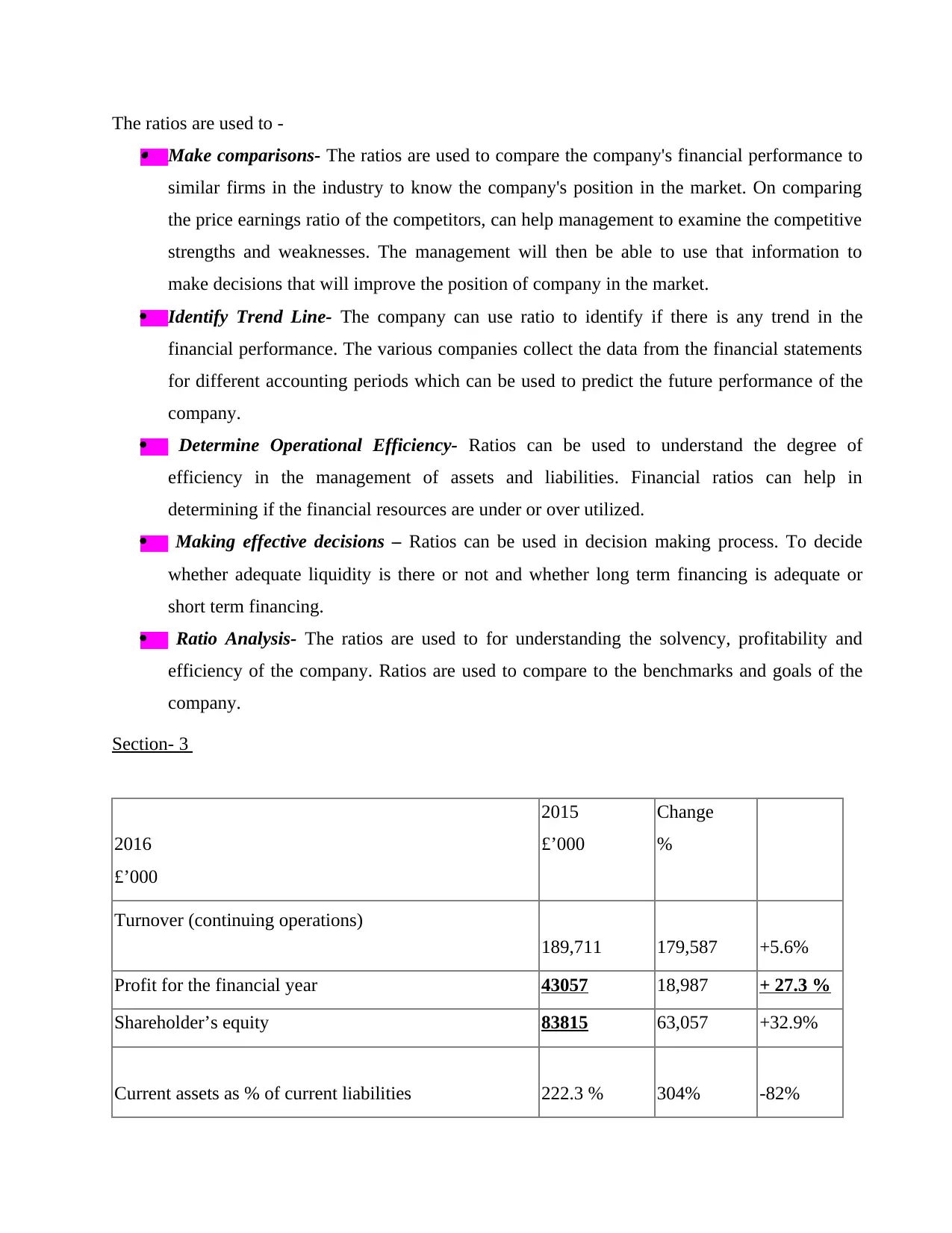
The ratios are used to - Make comparisons- The ratios are used to compare the company's financial performance to
similar firms in the industry to know the company's position in the market. On comparing
the price earnings ratio of the competitors, can help management to examine the competitive
strengths and weaknesses. The management will then be able to use that information to
make decisions that will improve the position of company in the market.
Identify Trend Line- The company can use ratio to identify if there is any trend in the
financial performance. The various companies collect the data from the financial statements
for different accounting periods which can be used to predict the future performance of the
company.
Determine Operational Efficiency- Ratios can be used to understand the degree of
efficiency in the management of assets and liabilities. Financial ratios can help in
determining if the financial resources are under or over utilized.
Making effective decisions – Ratios can be used in decision making process. To decide
whether adequate liquidity is there or not and whether long term financing is adequate or
short term financing.
Ratio Analysis- The ratios are used to for understanding the solvency, profitability and
efficiency of the company. Ratios are used to compare to the benchmarks and goals of the
company.
Section- 3
2016
£’000
2015
£’000
Change
%
Turnover (continuing operations)
189,711 179,587 +5.6%
Profit for the financial year 43057 18,987 + 27.3 %
Shareholder’s equity 83815 63,057 +32.9%
Current assets as % of current liabilities 222.3 % 304% -82%
similar firms in the industry to know the company's position in the market. On comparing
the price earnings ratio of the competitors, can help management to examine the competitive
strengths and weaknesses. The management will then be able to use that information to
make decisions that will improve the position of company in the market.
Identify Trend Line- The company can use ratio to identify if there is any trend in the
financial performance. The various companies collect the data from the financial statements
for different accounting periods which can be used to predict the future performance of the
company.
Determine Operational Efficiency- Ratios can be used to understand the degree of
efficiency in the management of assets and liabilities. Financial ratios can help in
determining if the financial resources are under or over utilized.
Making effective decisions – Ratios can be used in decision making process. To decide
whether adequate liquidity is there or not and whether long term financing is adequate or
short term financing.
Ratio Analysis- The ratios are used to for understanding the solvency, profitability and
efficiency of the company. Ratios are used to compare to the benchmarks and goals of the
company.
Section- 3
2016
£’000
2015
£’000
Change
%
Turnover (continuing operations)
189,711 179,587 +5.6%
Profit for the financial year 43057 18,987 + 27.3 %
Shareholder’s equity 83815 63,057 +32.9%
Current assets as % of current liabilities 222.3 % 304% -82%
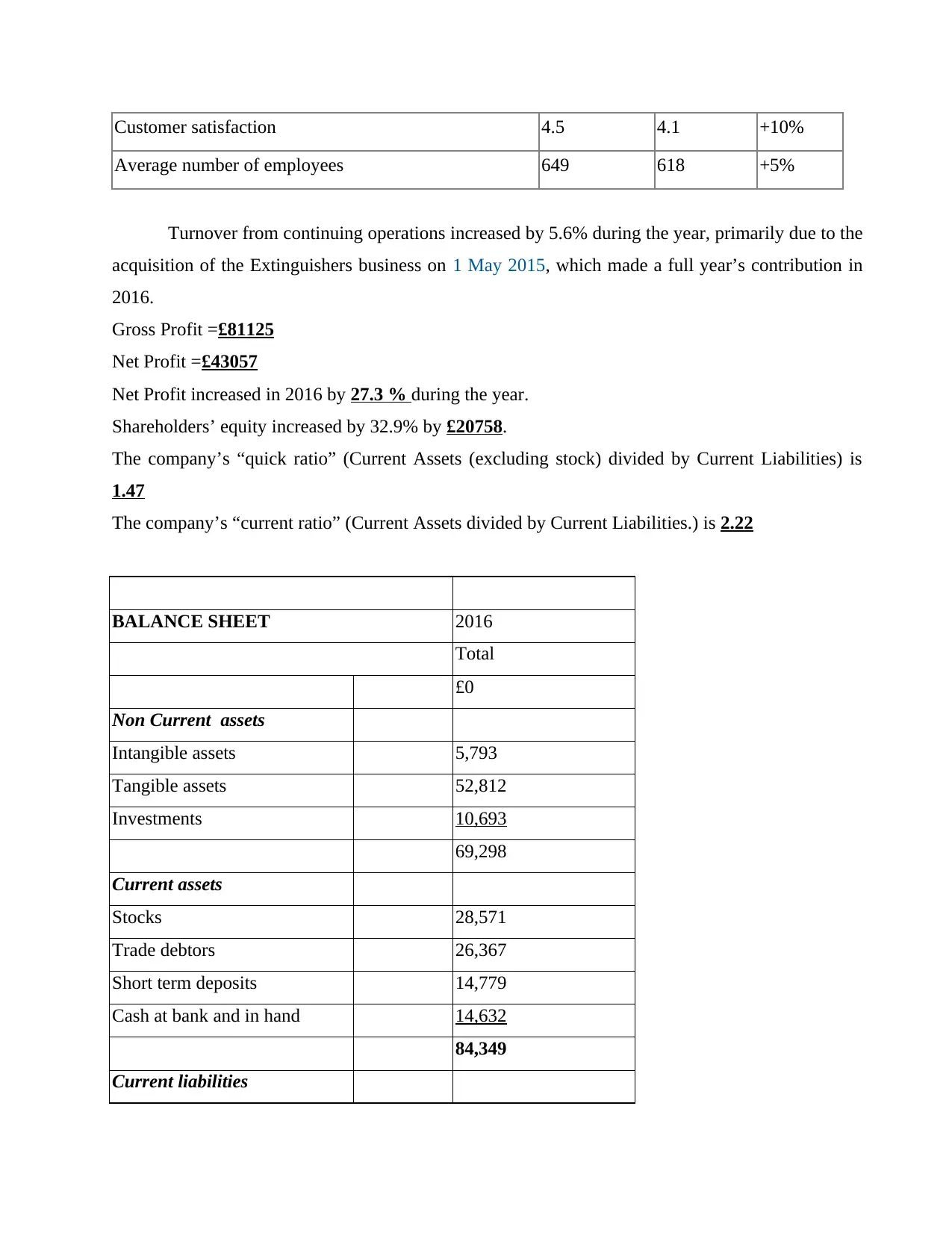
Customer satisfaction 4.5 4.1 +10%
Average number of employees 649 618 +5%
Turnover from continuing operations increased by 5.6% during the year, primarily due to the
acquisition of the Extinguishers business on 1 May 2015, which made a full year’s contribution in
2016.
Gross Profit =£81125
Net Profit =£43057
Net Profit increased in 2016 by 27.3 % during the year.
Shareholders’ equity increased by 32.9% by £20758.
The company’s “quick ratio” (Current Assets (excluding stock) divided by Current Liabilities) is
1.47
The company’s “current ratio” (Current Assets divided by Current Liabilities.) is 2.22
BALANCE SHEET 2016
Total
£0
Non Current assets
Intangible assets 5,793
Tangible assets 52,812
Investments 10,693
69,298
Current assets
Stocks 28,571
Trade debtors 26,367
Short term deposits 14,779
Cash at bank and in hand 14,632
84,349
Current liabilities
Average number of employees 649 618 +5%
Turnover from continuing operations increased by 5.6% during the year, primarily due to the
acquisition of the Extinguishers business on 1 May 2015, which made a full year’s contribution in
2016.
Gross Profit =£81125
Net Profit =£43057
Net Profit increased in 2016 by 27.3 % during the year.
Shareholders’ equity increased by 32.9% by £20758.
The company’s “quick ratio” (Current Assets (excluding stock) divided by Current Liabilities) is
1.47
The company’s “current ratio” (Current Assets divided by Current Liabilities.) is 2.22
BALANCE SHEET 2016
Total
£0
Non Current assets
Intangible assets 5,793
Tangible assets 52,812
Investments 10,693
69,298
Current assets
Stocks 28,571
Trade debtors 26,367
Short term deposits 14,779
Cash at bank and in hand 14,632
84,349
Current liabilities
⊘ This is a preview!⊘
Do you want full access?
Subscribe today to unlock all pages.

Trusted by 1+ million students worldwide
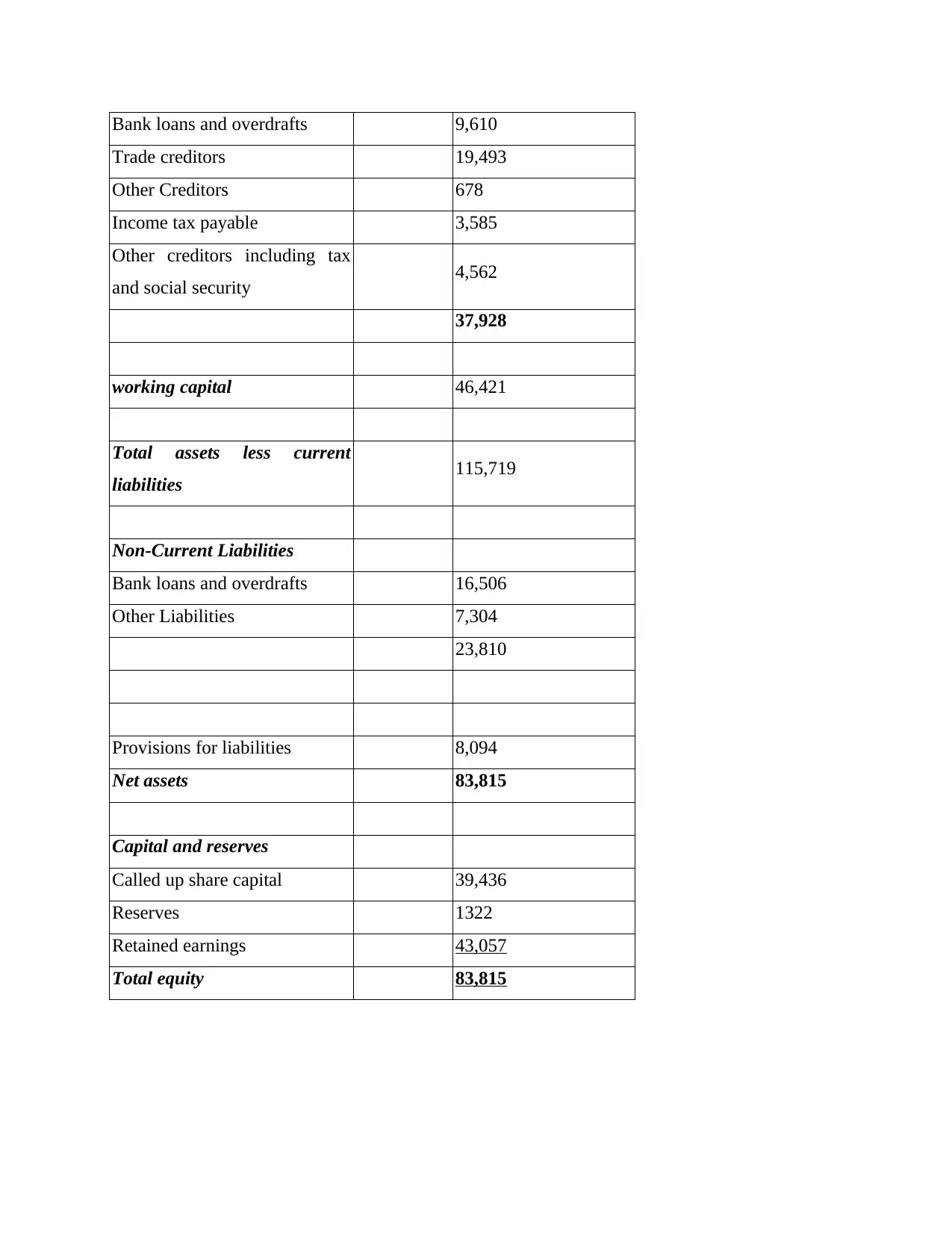
Bank loans and overdrafts 9,610
Trade creditors 19,493
Other Creditors 678
Income tax payable 3,585
Other creditors including tax
and social security 4,562
37,928
working capital 46,421
Total assets less current
liabilities 115,719
Non-Current Liabilities
Bank loans and overdrafts 16,506
Other Liabilities 7,304
23,810
Provisions for liabilities 8,094
Net assets 83,815
Capital and reserves
Called up share capital 39,436
Reserves 1322
Retained earnings 43,057
Total equity 83,815
Trade creditors 19,493
Other Creditors 678
Income tax payable 3,585
Other creditors including tax
and social security 4,562
37,928
working capital 46,421
Total assets less current
liabilities 115,719
Non-Current Liabilities
Bank loans and overdrafts 16,506
Other Liabilities 7,304
23,810
Provisions for liabilities 8,094
Net assets 83,815
Capital and reserves
Called up share capital 39,436
Reserves 1322
Retained earnings 43,057
Total equity 83,815
Paraphrase This Document
Need a fresh take? Get an instant paraphrase of this document with our AI Paraphraser
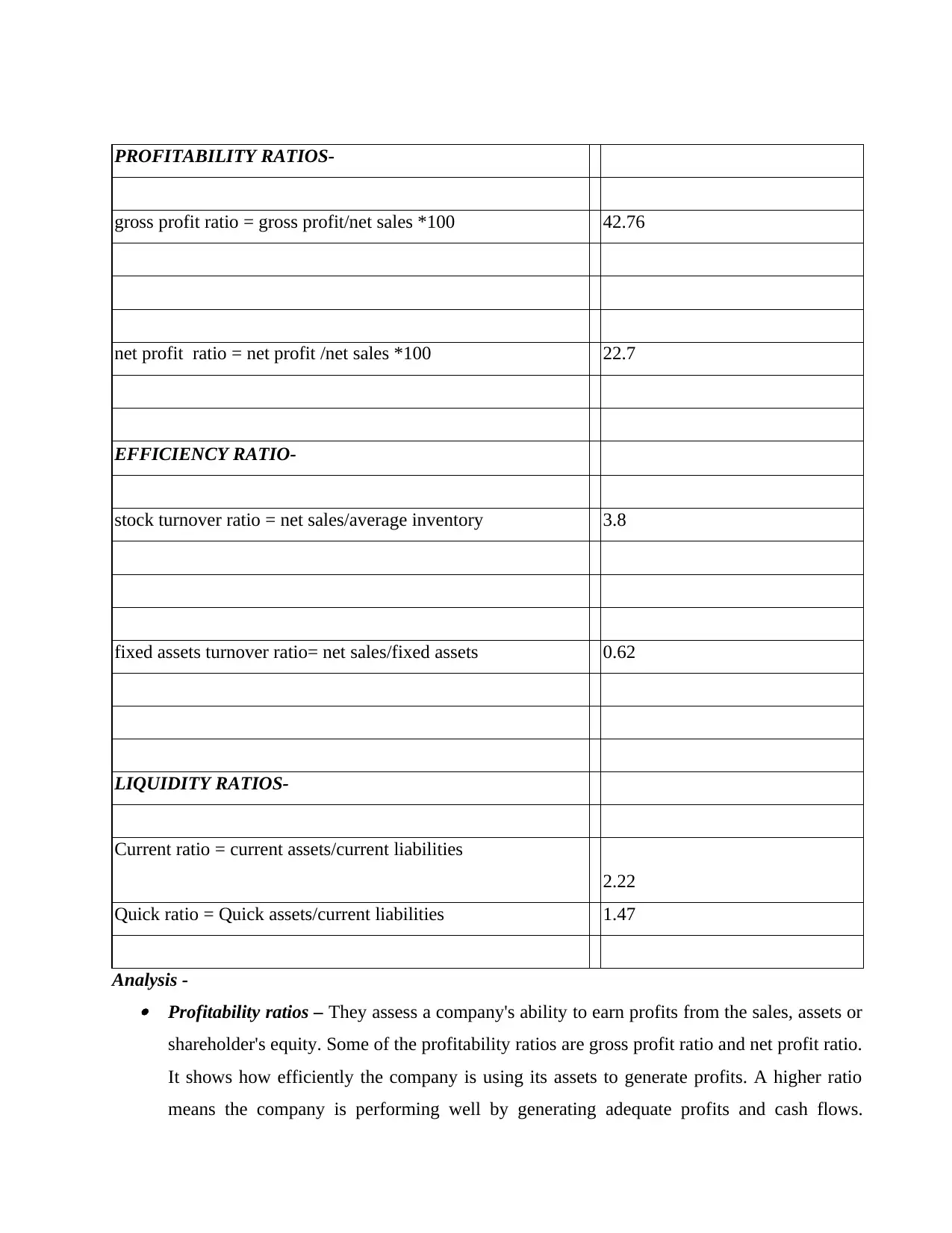
PROFITABILITY RATIOS-
gross profit ratio = gross profit/net sales *100 42.76
net profit ratio = net profit /net sales *100 22.7
EFFICIENCY RATIO-
stock turnover ratio = net sales/average inventory 3.8
fixed assets turnover ratio= net sales/fixed assets 0.62
LIQUIDITY RATIOS-
Current ratio = current assets/current liabilities
2.22
Quick ratio = Quick assets/current liabilities 1.47
Analysis - Profitability ratios – They assess a company's ability to earn profits from the sales, assets or
shareholder's equity. Some of the profitability ratios are gross profit ratio and net profit ratio.
It shows how efficiently the company is using its assets to generate profits. A higher ratio
means the company is performing well by generating adequate profits and cash flows.
gross profit ratio = gross profit/net sales *100 42.76
net profit ratio = net profit /net sales *100 22.7
EFFICIENCY RATIO-
stock turnover ratio = net sales/average inventory 3.8
fixed assets turnover ratio= net sales/fixed assets 0.62
LIQUIDITY RATIOS-
Current ratio = current assets/current liabilities
2.22
Quick ratio = Quick assets/current liabilities 1.47
Analysis - Profitability ratios – They assess a company's ability to earn profits from the sales, assets or
shareholder's equity. Some of the profitability ratios are gross profit ratio and net profit ratio.
It shows how efficiently the company is using its assets to generate profits. A higher ratio
means the company is performing well by generating adequate profits and cash flows.
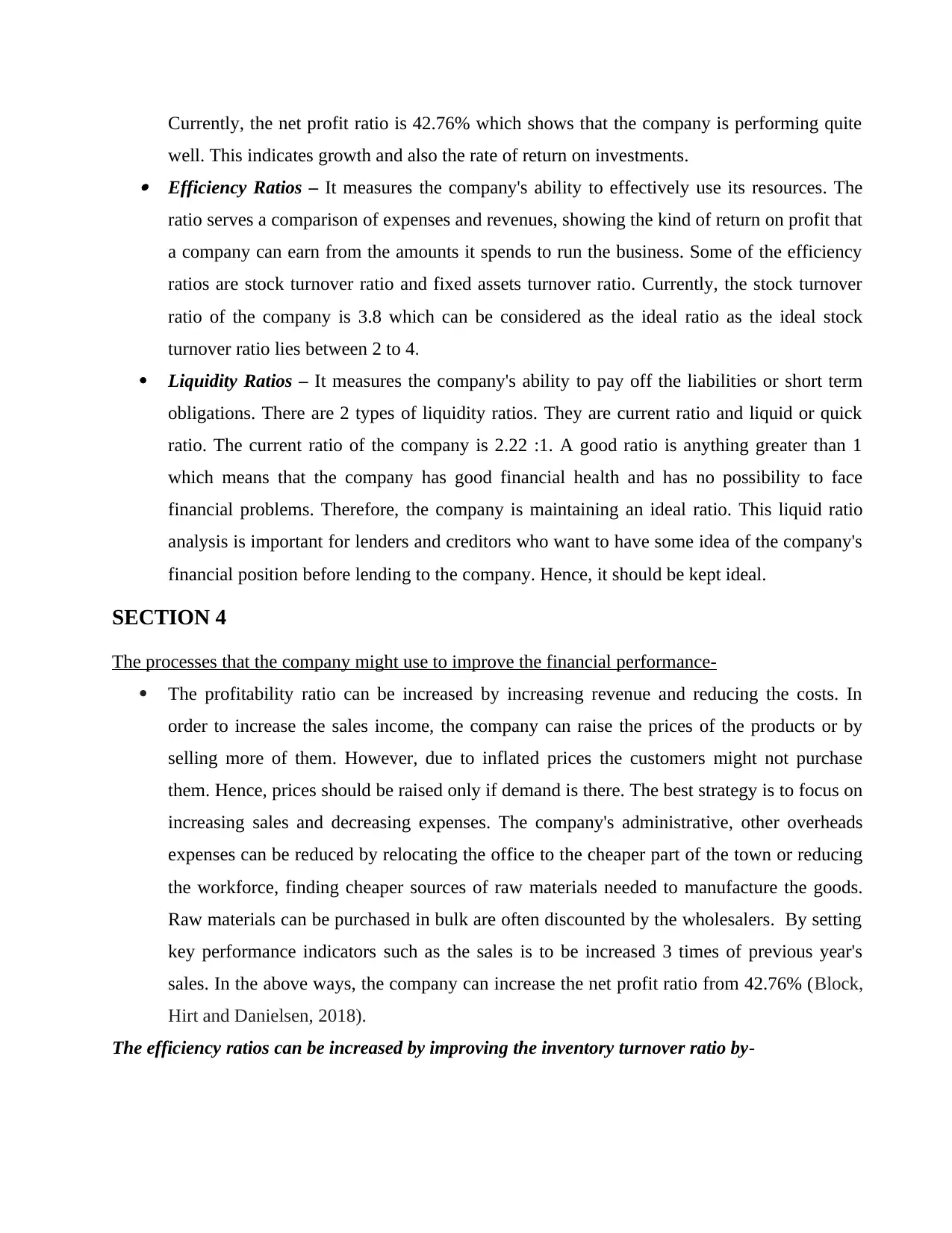
Currently, the net profit ratio is 42.76% which shows that the company is performing quite
well. This indicates growth and also the rate of return on investments. Efficiency Ratios – It measures the company's ability to effectively use its resources. The
ratio serves a comparison of expenses and revenues, showing the kind of return on profit that
a company can earn from the amounts it spends to run the business. Some of the efficiency
ratios are stock turnover ratio and fixed assets turnover ratio. Currently, the stock turnover
ratio of the company is 3.8 which can be considered as the ideal ratio as the ideal stock
turnover ratio lies between 2 to 4.
Liquidity Ratios – It measures the company's ability to pay off the liabilities or short term
obligations. There are 2 types of liquidity ratios. They are current ratio and liquid or quick
ratio. The current ratio of the company is 2.22 :1. A good ratio is anything greater than 1
which means that the company has good financial health and has no possibility to face
financial problems. Therefore, the company is maintaining an ideal ratio. This liquid ratio
analysis is important for lenders and creditors who want to have some idea of the company's
financial position before lending to the company. Hence, it should be kept ideal.
SECTION 4
The processes that the company might use to improve the financial performance-
The profitability ratio can be increased by increasing revenue and reducing the costs. In
order to increase the sales income, the company can raise the prices of the products or by
selling more of them. However, due to inflated prices the customers might not purchase
them. Hence, prices should be raised only if demand is there. The best strategy is to focus on
increasing sales and decreasing expenses. The company's administrative, other overheads
expenses can be reduced by relocating the office to the cheaper part of the town or reducing
the workforce, finding cheaper sources of raw materials needed to manufacture the goods.
Raw materials can be purchased in bulk are often discounted by the wholesalers. By setting
key performance indicators such as the sales is to be increased 3 times of previous year's
sales. In the above ways, the company can increase the net profit ratio from 42.76% (Block,
Hirt and Danielsen, 2018).
The efficiency ratios can be increased by improving the inventory turnover ratio by-
well. This indicates growth and also the rate of return on investments. Efficiency Ratios – It measures the company's ability to effectively use its resources. The
ratio serves a comparison of expenses and revenues, showing the kind of return on profit that
a company can earn from the amounts it spends to run the business. Some of the efficiency
ratios are stock turnover ratio and fixed assets turnover ratio. Currently, the stock turnover
ratio of the company is 3.8 which can be considered as the ideal ratio as the ideal stock
turnover ratio lies between 2 to 4.
Liquidity Ratios – It measures the company's ability to pay off the liabilities or short term
obligations. There are 2 types of liquidity ratios. They are current ratio and liquid or quick
ratio. The current ratio of the company is 2.22 :1. A good ratio is anything greater than 1
which means that the company has good financial health and has no possibility to face
financial problems. Therefore, the company is maintaining an ideal ratio. This liquid ratio
analysis is important for lenders and creditors who want to have some idea of the company's
financial position before lending to the company. Hence, it should be kept ideal.
SECTION 4
The processes that the company might use to improve the financial performance-
The profitability ratio can be increased by increasing revenue and reducing the costs. In
order to increase the sales income, the company can raise the prices of the products or by
selling more of them. However, due to inflated prices the customers might not purchase
them. Hence, prices should be raised only if demand is there. The best strategy is to focus on
increasing sales and decreasing expenses. The company's administrative, other overheads
expenses can be reduced by relocating the office to the cheaper part of the town or reducing
the workforce, finding cheaper sources of raw materials needed to manufacture the goods.
Raw materials can be purchased in bulk are often discounted by the wholesalers. By setting
key performance indicators such as the sales is to be increased 3 times of previous year's
sales. In the above ways, the company can increase the net profit ratio from 42.76% (Block,
Hirt and Danielsen, 2018).
The efficiency ratios can be increased by improving the inventory turnover ratio by-
⊘ This is a preview!⊘
Do you want full access?
Subscribe today to unlock all pages.

Trusted by 1+ million students worldwide
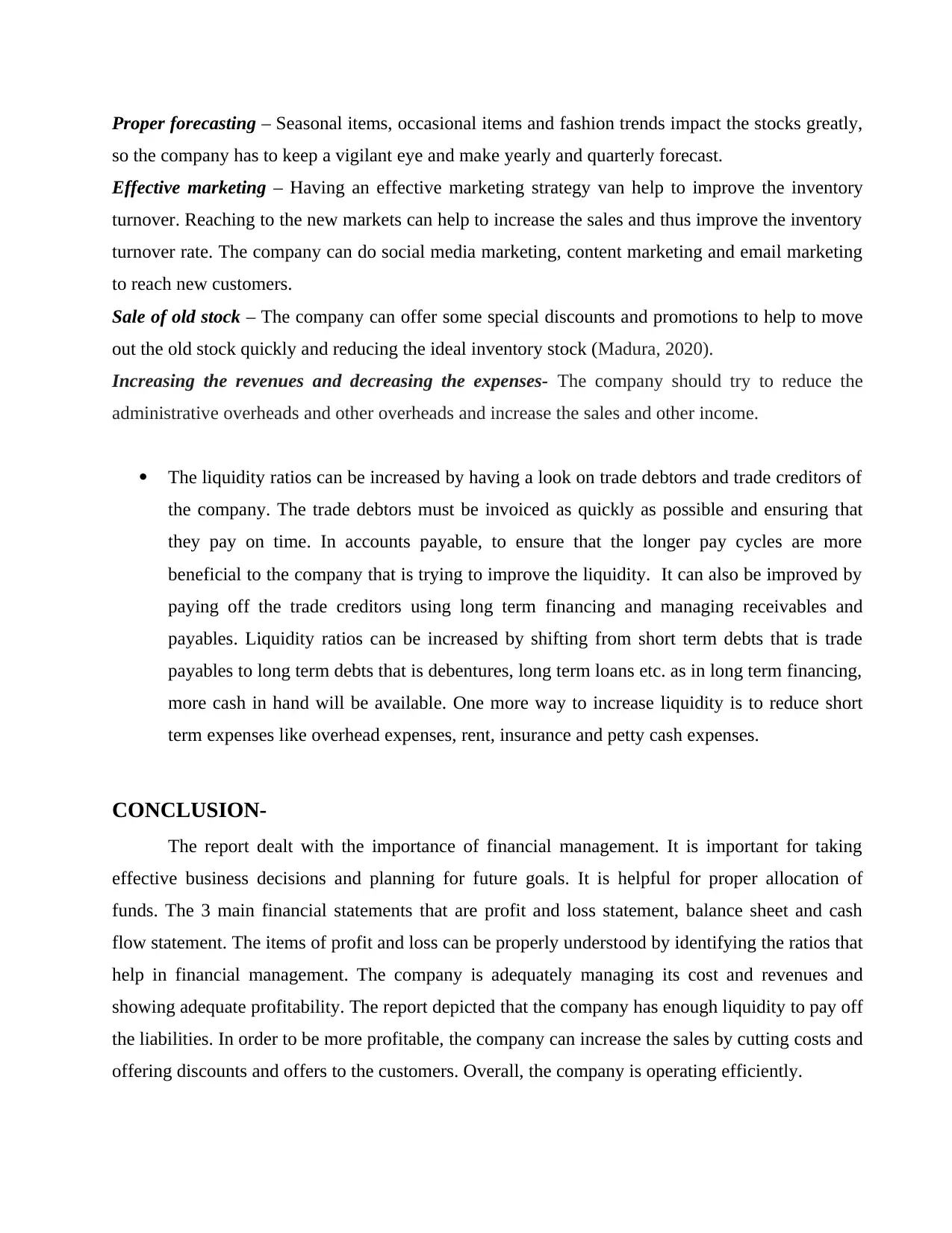
Proper forecasting – Seasonal items, occasional items and fashion trends impact the stocks greatly,
so the company has to keep a vigilant eye and make yearly and quarterly forecast.
Effective marketing – Having an effective marketing strategy van help to improve the inventory
turnover. Reaching to the new markets can help to increase the sales and thus improve the inventory
turnover rate. The company can do social media marketing, content marketing and email marketing
to reach new customers.
Sale of old stock – The company can offer some special discounts and promotions to help to move
out the old stock quickly and reducing the ideal inventory stock (Madura, 2020).
Increasing the revenues and decreasing the expenses- The company should try to reduce the
administrative overheads and other overheads and increase the sales and other income.
The liquidity ratios can be increased by having a look on trade debtors and trade creditors of
the company. The trade debtors must be invoiced as quickly as possible and ensuring that
they pay on time. In accounts payable, to ensure that the longer pay cycles are more
beneficial to the company that is trying to improve the liquidity. It can also be improved by
paying off the trade creditors using long term financing and managing receivables and
payables. Liquidity ratios can be increased by shifting from short term debts that is trade
payables to long term debts that is debentures, long term loans etc. as in long term financing,
more cash in hand will be available. One more way to increase liquidity is to reduce short
term expenses like overhead expenses, rent, insurance and petty cash expenses.
CONCLUSION-
The report dealt with the importance of financial management. It is important for taking
effective business decisions and planning for future goals. It is helpful for proper allocation of
funds. The 3 main financial statements that are profit and loss statement, balance sheet and cash
flow statement. The items of profit and loss can be properly understood by identifying the ratios that
help in financial management. The company is adequately managing its cost and revenues and
showing adequate profitability. The report depicted that the company has enough liquidity to pay off
the liabilities. In order to be more profitable, the company can increase the sales by cutting costs and
offering discounts and offers to the customers. Overall, the company is operating efficiently.
so the company has to keep a vigilant eye and make yearly and quarterly forecast.
Effective marketing – Having an effective marketing strategy van help to improve the inventory
turnover. Reaching to the new markets can help to increase the sales and thus improve the inventory
turnover rate. The company can do social media marketing, content marketing and email marketing
to reach new customers.
Sale of old stock – The company can offer some special discounts and promotions to help to move
out the old stock quickly and reducing the ideal inventory stock (Madura, 2020).
Increasing the revenues and decreasing the expenses- The company should try to reduce the
administrative overheads and other overheads and increase the sales and other income.
The liquidity ratios can be increased by having a look on trade debtors and trade creditors of
the company. The trade debtors must be invoiced as quickly as possible and ensuring that
they pay on time. In accounts payable, to ensure that the longer pay cycles are more
beneficial to the company that is trying to improve the liquidity. It can also be improved by
paying off the trade creditors using long term financing and managing receivables and
payables. Liquidity ratios can be increased by shifting from short term debts that is trade
payables to long term debts that is debentures, long term loans etc. as in long term financing,
more cash in hand will be available. One more way to increase liquidity is to reduce short
term expenses like overhead expenses, rent, insurance and petty cash expenses.
CONCLUSION-
The report dealt with the importance of financial management. It is important for taking
effective business decisions and planning for future goals. It is helpful for proper allocation of
funds. The 3 main financial statements that are profit and loss statement, balance sheet and cash
flow statement. The items of profit and loss can be properly understood by identifying the ratios that
help in financial management. The company is adequately managing its cost and revenues and
showing adequate profitability. The report depicted that the company has enough liquidity to pay off
the liabilities. In order to be more profitable, the company can increase the sales by cutting costs and
offering discounts and offers to the customers. Overall, the company is operating efficiently.
Paraphrase This Document
Need a fresh take? Get an instant paraphrase of this document with our AI Paraphraser
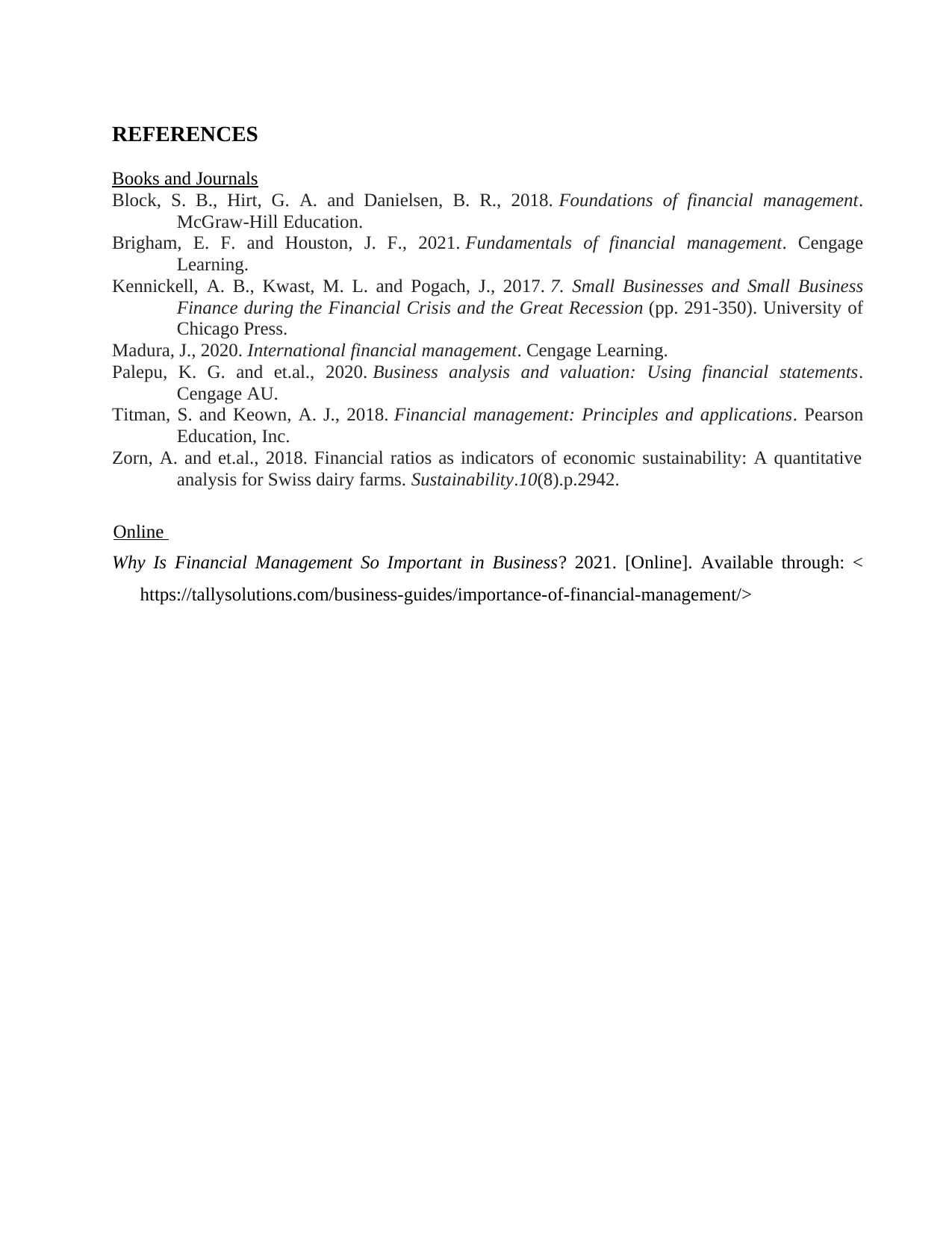
REFERENCES
Books and Journals
Block, S. B., Hirt, G. A. and Danielsen, B. R., 2018. Foundations of financial management.
McGraw-Hill Education.
Brigham, E. F. and Houston, J. F., 2021. Fundamentals of financial management. Cengage
Learning.
Kennickell, A. B., Kwast, M. L. and Pogach, J., 2017. 7. Small Businesses and Small Business
Finance during the Financial Crisis and the Great Recession (pp. 291-350). University of
Chicago Press.
Madura, J., 2020. International financial management. Cengage Learning.
Palepu, K. G. and et.al., 2020. Business analysis and valuation: Using financial statements.
Cengage AU.
Titman, S. and Keown, A. J., 2018. Financial management: Principles and applications. Pearson
Education, Inc.
Zorn, A. and et.al., 2018. Financial ratios as indicators of economic sustainability: A quantitative
analysis for Swiss dairy farms. Sustainability.10(8).p.2942.
Online
Why Is Financial Management So Important in Business? 2021. [Online]. Available through: <
https://tallysolutions.com/business-guides/importance-of-financial-management/>
Books and Journals
Block, S. B., Hirt, G. A. and Danielsen, B. R., 2018. Foundations of financial management.
McGraw-Hill Education.
Brigham, E. F. and Houston, J. F., 2021. Fundamentals of financial management. Cengage
Learning.
Kennickell, A. B., Kwast, M. L. and Pogach, J., 2017. 7. Small Businesses and Small Business
Finance during the Financial Crisis and the Great Recession (pp. 291-350). University of
Chicago Press.
Madura, J., 2020. International financial management. Cengage Learning.
Palepu, K. G. and et.al., 2020. Business analysis and valuation: Using financial statements.
Cengage AU.
Titman, S. and Keown, A. J., 2018. Financial management: Principles and applications. Pearson
Education, Inc.
Zorn, A. and et.al., 2018. Financial ratios as indicators of economic sustainability: A quantitative
analysis for Swiss dairy farms. Sustainability.10(8).p.2942.
Online
Why Is Financial Management So Important in Business? 2021. [Online]. Available through: <
https://tallysolutions.com/business-guides/importance-of-financial-management/>
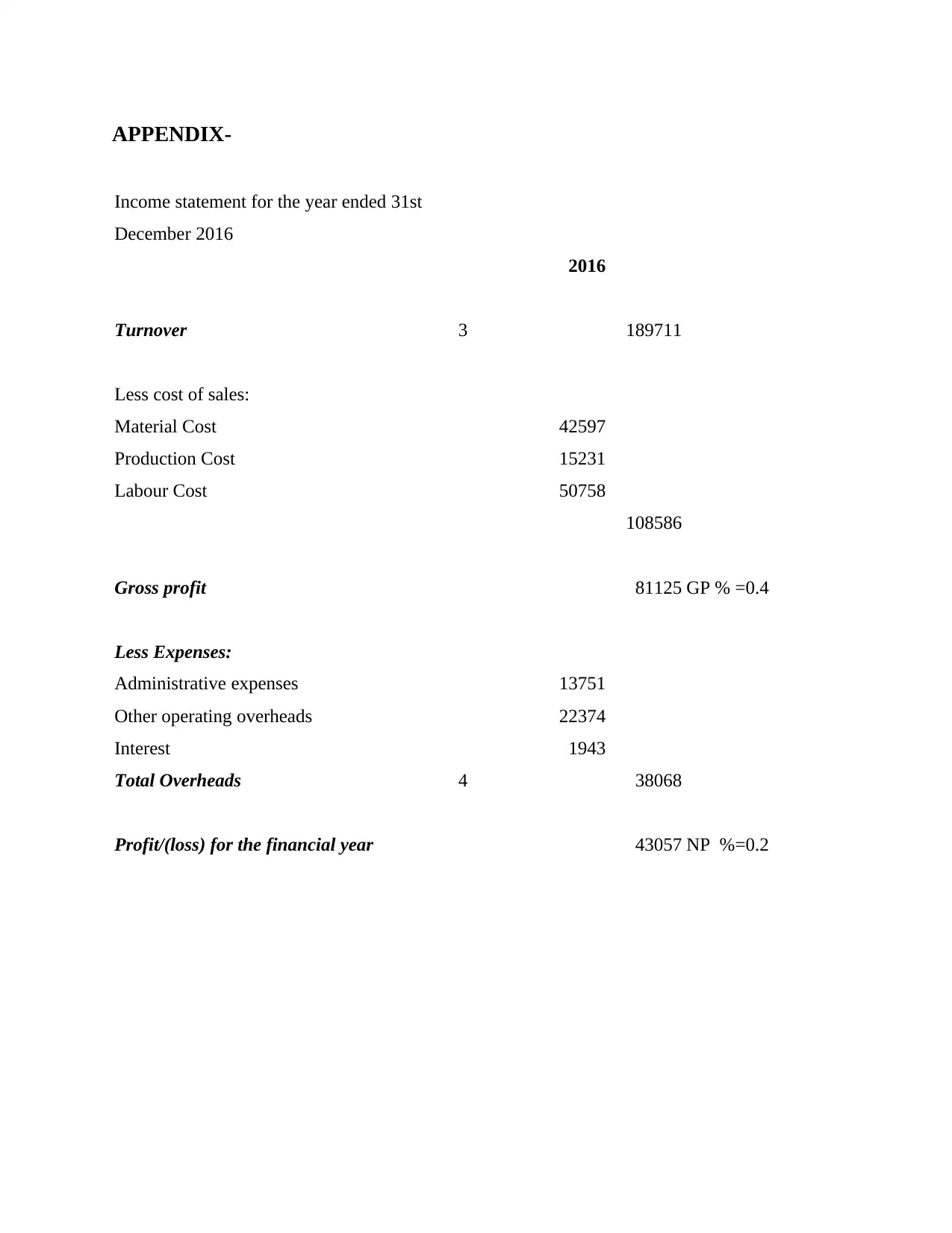
APPENDIX-
Income statement for the year ended 31st
December 2016
2016
Turnover 3 189711
Less cost of sales:
Material Cost 42597
Production Cost 15231
Labour Cost 50758
108586
Gross profit 81125 GP % =0.4
Less Expenses:
Administrative expenses 13751
Other operating overheads 22374
Interest 1943
Total Overheads 4 38068
Profit/(loss) for the financial year 43057 NP %=0.2
Income statement for the year ended 31st
December 2016
2016
Turnover 3 189711
Less cost of sales:
Material Cost 42597
Production Cost 15231
Labour Cost 50758
108586
Gross profit 81125 GP % =0.4
Less Expenses:
Administrative expenses 13751
Other operating overheads 22374
Interest 1943
Total Overheads 4 38068
Profit/(loss) for the financial year 43057 NP %=0.2
⊘ This is a preview!⊘
Do you want full access?
Subscribe today to unlock all pages.

Trusted by 1+ million students worldwide
1 out of 12
Related Documents
Your All-in-One AI-Powered Toolkit for Academic Success.
+13062052269
info@desklib.com
Available 24*7 on WhatsApp / Email
![[object Object]](/_next/static/media/star-bottom.7253800d.svg)
Unlock your academic potential
Copyright © 2020–2025 A2Z Services. All Rights Reserved. Developed and managed by ZUCOL.


